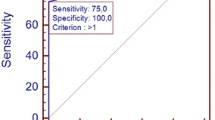Abstract
Ventricular free wall rupture is a catastrophic complication of acute myocardial infarction accounting for a significant proportion of in-patient deaths. Various imaging modalities including two-dimensional and contrast echocardiography have been applied for the early diagnosis of free wall rupture. Cardiac magnetic resonance imaging has recently gained favor as a tool providing accurate diagnosis and visualization of the site of rupture to enable planned surgery. We present a case of subacute free wall rupture where contrast enhanced myocardial resonance imaging helped to delineate the location and extent of the myocardial tear, thereby prompting appropriate surgical intervention.
Similar content being viewed by others
References
Slater J, Brown RJ, Antonelli TA, Menon V, Boland J, Col J, Dzavik V, Greenberg M, Menegus M, Connery C, Hochman JS (2000) Cardiogenic shock due to cardiac free-wall rupture or tamponade after acute myocardial infarction: a report from the SHOCK Trial Registry. Should we emergently revascularize occluded coronaries for cardiogenic shock? J Am Coll Cardiol 36:1117–1122
Birnbaum Y, Fishbein MC, Blanche C, Siegel RJ (2002) Ventricular septal rupture after acute myocardial infarction. N Engl J Med 347:1426–1432
Figueras J, Cortadellas J, Soler-Soler J (2000) Left ventricular free wall rupture: clinical presentation and management. Heart 83: 499–504
Perdigao C, Andrade A, Ribeiro M, Monteiro J, Ribeiro C (1990) Incidence and forms of clinical presentation of the various morphologic types of myocardial laceration in the acute phase of infarct. A 4 years’ caseload at a coronary unit. A clinico-anatomic study of 193 successive cases. Rev Port Cardiol 9:587–598
Raitt MH, Kraft CD, Gardner CJ, Pearlman AS, Otto CM (1993) Subacute ventricular free wall rupture complicating myocardial infarction. Am Heart J 126:946–955
Tanaka K, Sato N, Yasutake M, Takeda S, Takano T, Tanaka S (2002) Clinical course, timing of rupture and relationship with coronary recanalization therapy in 77 patients with ventricular free wall rupture following acute myocardial infarction. J Nippon Med Sch 69:481–488
Becker RC, Hochman JS, Cannon CP, Spencer FA, Ball SP, Rizzo MJ, Antman EM (1999) Fatal cardiac rupture among patients treated with thrombolytic agents and adjunctive thrombin antagonists: observations from the Thrombolysis and Thrombin Inhibition in Myocardial Infarction 9 Study. J Am Coll Cardiol 33:479–487
Moreno R, Lopez-Sendon J, Garcia E, Perez de Isla L, Lopez de Sa E, Ortega A, Moreno M, Rubio R, Soriano J, Abeytua M, Garcia-Fernandez MA (2002) Primary angioplasty reduces the risk of left ventricular free wall rupture compared with thrombolysis in patients with acute myocardial infarction. J Am Coll Cardiol 39: 598–603
Tanaka M, Goto Y, Suzuki S, Morii I, Otsuka Y, Miyazaki S, Nonogi H (2006) Postinfarction cardiac rupture despite immediate reperfusion therapy in a patient with severe aortic valve stenosis. Heart Vessels 21:59–62
Fang L, Gao XM, Moore XL, Kiriazis H, Su Y, Ming Z, Lim YL, Dart AM, Du XJ (2007) Differences in inflammation, MMP activation and collagen damage account for gender difference in murine cardiac rupture following myocardial infarction. J Mol Cell Cardiol 43:535–544
Lopez-Sendon J, Gonzalez A, Lopez de Sa E, Coma-Canella I, Roldan I, Dominguez F, Maqueda I, Martin Jadraque L (1992) Diagnosis of subacute ventricular wall rupture after acute myocardial infarction: sensitivity and specificity of clinical, hemodynamic and echocardiographic criteria. J Am Coll Cardiol 19:1145–1153
Shiozaki AA, Filho RA, Dallan LA, de Oliveira SA, Nicolau JC, Rochitte CE (2007) Left ventricular free-wall rupture after acute myocardial infarction imaged by cardiovascular magnetic resonance. J Cardiovasc Magn Reson 9:719–721
Matoh F, Hayashi H, Terada H, Satoh H, Katoh H, Urushida T, Shiraki K, Asai M, Sakahara H, Takehara Y (2005) Usefulness of delayed enhancement magnetic resonance imaging for detecting cardiac rupture caused by small myocardial infarction in a case of cardiac tamponade. Circ J 69:1556–1559
Albert TS, Kim RJ, Judd RM (2006) Assessment of no-reflow regions using cardiac MRI. Basic Res Cardiol 101:383–390
Takase B, Kihara T, Noya K, Abe Y, Nagata M, Ohsuzu F, Ishihara M (2006) Usefulness of cardiac magnetic resonance imaging for detecting acute myocardial infarction in patients with no significant electrocardiogram changes. Heart Vessels 21:131–134
Zoni A, Arisi A, Corradi D, Ardissino D (2003) Images in cardiovascular medicine. Magnetic resonance imaging of impending left ventricular rupture after acute myocardial infarction. Circulation 108:498–499
Author information
Authors and Affiliations
Corresponding author
Rights and permissions
About this article
Cite this article
Krishnan, U., McCann, G.P., Hickey, M. et al. Role of contrast-enhanced magnetic resonance imaging in detecting early adverse remodeling and subacute ventricular wall rupture complicating myocardial infarction. Heart Vessels 23, 430–432 (2008). https://doi.org/10.1007/s00380-008-1063-8
Received:
Accepted:
Published:
Issue Date:
DOI: https://doi.org/10.1007/s00380-008-1063-8




